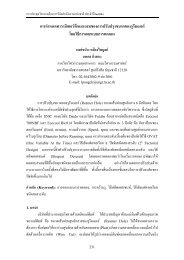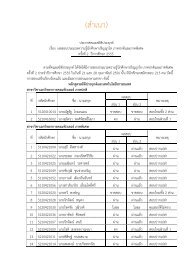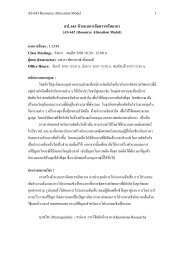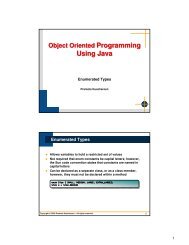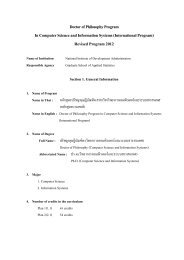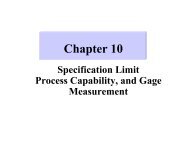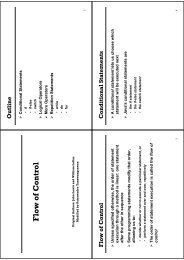ดาวน์โหลด All Proceeding - AS Nida
ดาวน์โหลด All Proceeding - AS Nida
ดาวน์โหลด All Proceeding - AS Nida
Create successful ePaper yourself
Turn your PDF publications into a flip-book with our unique Google optimized e-Paper software.
limitation of computational time and resources required for<br />
computational experiments, five benchmarking instances (see Table 4)<br />
of JSSP were selected from the OR-Library [11]. The selection of those<br />
instant problems was considered from the size of searching space<br />
determined by two parameters: n jobs to be performed on m machines<br />
(n × m dimensions). <strong>All</strong> computational runs were based on personal<br />
computers with Core 2 Duo 2.67 GHz CPU with 4 GB DDR2 RAM.<br />
Table 4. Benchmarking JSSP instance datasets selected from the OR-<br />
Library [11].<br />
Instances<br />
Problem size<br />
(n × m)<br />
Number of<br />
jobs (n)<br />
Number of<br />
machines (m)<br />
FT06 6 × 6 6 6<br />
LA05 10 × 5 10 5<br />
LA10 15 × 5 15 5<br />
LA15 20 × 5 20 5<br />
LA21 15 × 10 15 10<br />
4.1 Identifying appropriate setting of FA parameters<br />
The first experiment aimed to investigate the appropriate<br />
setting of the FA parameters via experimental design and statistical<br />
analysis. Due to several parameters and levels of FA, full factional<br />
experimental design requires high computational resources and time<br />
consuming because of large number of experimental runs for each<br />
replication. Therefore, one-third fractional factorial experimental design<br />
(3 k-1 ) [27] was adopted in this work. The FA factors and it levels in this<br />
work are summarised in Table 5. Those factors are the combination of<br />
the amount of fireflies (n) and the number of maximum generations (G):<br />
nG, the light absorption coefficient (γ), the randomisation parameter<br />
(α), and the maximum attractiveness value (β 0). Generally, the<br />
combination factor (nG) determines the amount of search (candidate<br />
solutions) in the solution space conducted by the FA. This factor is<br />
directly related with the size of the problem considered. The high value<br />
of this combination usually increases the probability of getting the best<br />
solution but requires longer computational time and resources. In this<br />
work, the computational limitations are practically imposed; this<br />
combination (nG) was therefore fixed at 2,500 in order to accommodate<br />
the computational search within the time limit. The γ factor was varied<br />
from 0 to 10, while the range of remaining factors (both α and β 0) were<br />
set between 0 to 1 [9, 23].<br />
94<br />
Table 5. FA’s parameters and its levels considered.<br />
Factors Levels<br />
Low (-1)<br />
Uncoded Values<br />
Medium (0) High (+1)<br />
nG 3 25*100 50*50 100*25<br />
γ 3 0.1 5 10<br />
α 3 0 0.5 1<br />
β 0 3 0 0.5 1<br />
The LA21 problem instance was computationally<br />
experimented with ten replications by using different random seed<br />
numbers. The computational results obtained from 270 (3 4-1 *10) runs<br />
were analysed using a general linear model form of analysis of variance<br />
(ANOVA). Table 6 shows an ANOVA table consisting of Source of<br />
Variation (Source), Degrees of Freedom (DF), Sum of Square (SS),<br />
Mean Square (MS), and F and P values. A factor with value of P ≤ 0.05<br />
was considered statistically significant with a 95% confidence interval.<br />
Table 6. Analysis of variance (ANOVA) on the FA parameters.<br />
Source DF SS MS F P<br />
nG 2 141619 70809 32.54 0.000<br />
α 2 1393894 696947 320.29 0.000<br />
β 0 2 141845 70923 32.59 0.000<br />
γ 2 57165 28583 13.14 0.000<br />
Seeds 9 32975 3664 1.68 0.093<br />
Error 252 548355 2176<br />
Total 269 2315854<br />
From Table 6, it can be seen that all FA parameters<br />
including nG, α, β 0, and γ were statistically significant in terms of the<br />
main effect with a 95% confidence interval. The most influencing factor<br />
was the α factor because of the highest F value, followed by β 0, nG, and<br />
γ, respectively. The main effect plots are shown in Figure 6, suggesting<br />
that the main factors including nG, α, β 0, and γ should be defined at<br />
100*25, 0.5 or 1, 0.5 or 1, and 0.1, respectively. In practical, the<br />
appropriate parameters setting of the FA obtained from main effect<br />
plots should be selected based on minimum average makespan values as<br />
follows: nG, α, β 0, and γ parameters should be set at 100*25, 0.5, 1, and<br />
0.1, respectively.




